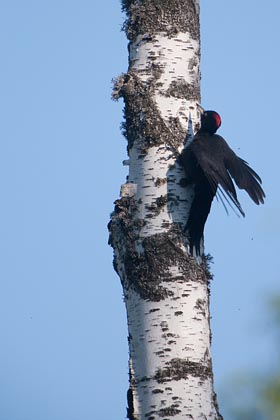A little about the black woodpecker
Photo: Arne Ader
Translation: Liis
Black woodpecker
Black woodpecker Musträhn Dryocopus martius
Compared to our other woodpeckers the black woodpecker is a big bird, almost of a size comparable to that of hooded crows: length more than 40 centimetres, weight over 300 grams and wing span all of 70 centimetres. basically sedentary birds that occasionally roam about.
As insect eater it is active in the lower parts of forests, furiously demolishing decomposing tree stumps of which only splinters are left, looking for ants. In winter it breaks up the frozen upper crust of red wood ants’ nests, gouging out tunnels through which it gets at the wintering ants …
A little about the exterior: the male has a red „stationmaster’s cap“ on his crown, the female only a red patch at the nape. Six to nine thousand black woodpecker pairs nested in Estonia in summer and they hatched three to five eggs. The young birds already look like the adults but if we manage to study a bird undisturbed we will see whom we have to do with: the beak base of adults is whitish and the tip of the beak black, a young bird’s beak is still wholly yellowish. The dark pupil of black woodpeckers is oval, eye colour of adults yellowish and of young birds bluish grey. The jet black plumage only needs to be mentioned and the legs are grey.
Very cautious as to behaviour, but at the same time curious birds that when disturbed leave accompanied by a drawn-out loud „kljii“ call.
In summer houses in undisturbed forest environments black woodpeckers sometimes drill holes in the eave boards as well as in the walls in the autumn-winter period. Theories about why they do so are many and different; any deterrents they quickly evaluate as harmless for their doings.
Black woodpecker observations in the e-Biodiversity database









